Caryn
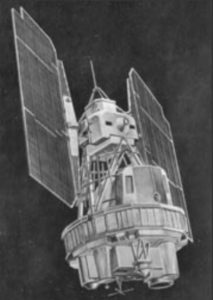 After the Soviet Union launched Sputnik, the world’s first satellite, on October 4, 1957, inspiring the United States to keep up, or fall behind in the Cold War, the United States launched it’s first satellite on January 31, 1958. That satellite was called Explorer 1, and followed the first two Soviet satellites the previous year…Sputnik 1 and 2. It was the beginning the Cold War Space Race between the two nations. Explorer 1 had mercury batteries that powered the high-power transmitter for 31 days and the low-power transmitter for 105 days. Explorer 1 stopped transmission of data on May 23, 1958 when its batteries died, but remained in orbit for more than 12 years. It reentered the atmosphere over the Pacific Ocean on March 31, 1970 after more than 58,000 orbits. The Explorer 1 payload consisted of the Iowa Cosmic Ray Instrument. It was without a tape data recorder, which was not modified in time to make it onto the spacecraft. The real-time data received on the ground was therefore very sparse and puzzling showing normal counting rates and no counts at all. I’m not sure what the counting was all about, so I guess I’m more confused than the scientists were. The later Explorer 3 mission, which included a tape data recorder in the payload, provided the additional data for confirmation of the earlier Explorer 1 data.
After the Soviet Union launched Sputnik, the world’s first satellite, on October 4, 1957, inspiring the United States to keep up, or fall behind in the Cold War, the United States launched it’s first satellite on January 31, 1958. That satellite was called Explorer 1, and followed the first two Soviet satellites the previous year…Sputnik 1 and 2. It was the beginning the Cold War Space Race between the two nations. Explorer 1 had mercury batteries that powered the high-power transmitter for 31 days and the low-power transmitter for 105 days. Explorer 1 stopped transmission of data on May 23, 1958 when its batteries died, but remained in orbit for more than 12 years. It reentered the atmosphere over the Pacific Ocean on March 31, 1970 after more than 58,000 orbits. The Explorer 1 payload consisted of the Iowa Cosmic Ray Instrument. It was without a tape data recorder, which was not modified in time to make it onto the spacecraft. The real-time data received on the ground was therefore very sparse and puzzling showing normal counting rates and no counts at all. I’m not sure what the counting was all about, so I guess I’m more confused than the scientists were. The later Explorer 3 mission, which included a tape data recorder in the payload, provided the additional data for confirmation of the earlier Explorer 1 data.
Landsat 1, which was originally named “Earth Resources Technology Satellite 1”, was the first satellite in the United States’ Landsat program. It was the first satellite that was launched with the sole purpose of studying and monitoring the planet. Landsat 1 was a modified version of the Nimbus 4 meteorological satellite and was launched on July 23, 1972 by a Delta 900 rocket from Vandenberg Air Force Base in California. Its orbit was near-polar and it served as a stabilized, Earth-oriented platform for obtaining information on agricultural and forestry resources, geology and mineral resources, hydrology and water resources, geography, cartography, environmental pollution, oceanography and marine resources, and meteorological phenomena. The spacecraft was placed in a sun-synchronous orbit, with an altitude between 564 and 569 miles. The spacecraft was placed in an orbit with an inclination of 99 degrees which orbited the Earth every 103 minutes. The project was renamed to Landsat in 1975.
Landsat 1 had two sensors to achieve its primary objectives…the return beam Vidicon (RBV) and the multispectral scanner (MSS). The RBV was manufactured by the Radio Corporation of America (RCA). The RBV obtained visible light and near infrared photographic images of Earth. It was considered the primary sensor. The MSS sensor manufactured by Hughes Aircraft Company was considered an experimental and secondary sensor, until scientists reviewed the data that was beamed back to Earth. After the data was reviewed, the MSS 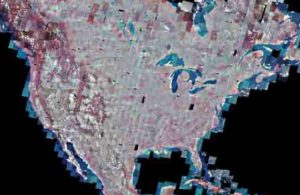 was considered the primary sensor. The MSS was a four-channel scanner that obtained radiometric images of Earth. From launch until 1974, Landsat 1 transmitted over 100,000 images, which covered more than 75% of the Earth’s surface. The RBV only took 1690 images. In 1976, Landsat 1 discovered a tiny uninhabited island 12 miles off the eastern coast of Canada. This island was named Landsat Island after the satellite. The MSS provided more than 300,000 images over the lifespan of the satellite. NASA oversaw 300 researchers that evaluated the data that Landsat 1 transmitted back to Earth. The Landsat 1 satellite sent data back to earth from its orbit until January of 1978 when its tape recorders malfunctioned. After that, it was taken out of service.
was considered the primary sensor. The MSS was a four-channel scanner that obtained radiometric images of Earth. From launch until 1974, Landsat 1 transmitted over 100,000 images, which covered more than 75% of the Earth’s surface. The RBV only took 1690 images. In 1976, Landsat 1 discovered a tiny uninhabited island 12 miles off the eastern coast of Canada. This island was named Landsat Island after the satellite. The MSS provided more than 300,000 images over the lifespan of the satellite. NASA oversaw 300 researchers that evaluated the data that Landsat 1 transmitted back to Earth. The Landsat 1 satellite sent data back to earth from its orbit until January of 1978 when its tape recorders malfunctioned. After that, it was taken out of service.
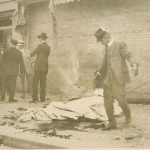 Most people would agree that the prospect of taking a nation into war is a scary one at best…especially for its citizens. In 1916, the world was in the middle of World War I. Isolationism had been the order of the day, as the United States tried to stay out of this war, but by the summer of 1916, with the Great War raging in Europe, and with the United States and other neutral ships threatened by German submarine aggression, it had become clear to many in the United States that their country could no longer stand on the sidelines. With that in mind, some of the leading business figures in San Francisco planned a parade in honor of American military preparedness. The day was dubbed Preparedness Day, and with the isolationist, anti-war, and anti-preparedness feeling that still ran high among a significant population of the city…and the country, not only among such radical organizations as International Workers of the World (the so-called “Wobblies”) but among mainstream labor leaders. These opponents of the Preparedness Day event undoubtedly shared the view voiced publicly by one critic, former U.S. Secretary of State William Jennings Bryan, who claimed that the organizers, San Francisco’s financiers and factory owners, were acting in pure self-interest, as they clearly stood to benefit from an increased production of munitions. At the same time, with the rise of Bolshevism and labor unrest, San Francisco’s business community was justifiably nervous. The Chamber of Commerce organized a Law and Order Committee, despite the diminishing influence and political clout of local labor organizations. Radical labor was a small but vociferous minority which few took seriously. Nevertheless, it became obvious that violence was imminent.
Most people would agree that the prospect of taking a nation into war is a scary one at best…especially for its citizens. In 1916, the world was in the middle of World War I. Isolationism had been the order of the day, as the United States tried to stay out of this war, but by the summer of 1916, with the Great War raging in Europe, and with the United States and other neutral ships threatened by German submarine aggression, it had become clear to many in the United States that their country could no longer stand on the sidelines. With that in mind, some of the leading business figures in San Francisco planned a parade in honor of American military preparedness. The day was dubbed Preparedness Day, and with the isolationist, anti-war, and anti-preparedness feeling that still ran high among a significant population of the city…and the country, not only among such radical organizations as International Workers of the World (the so-called “Wobblies”) but among mainstream labor leaders. These opponents of the Preparedness Day event undoubtedly shared the view voiced publicly by one critic, former U.S. Secretary of State William Jennings Bryan, who claimed that the organizers, San Francisco’s financiers and factory owners, were acting in pure self-interest, as they clearly stood to benefit from an increased production of munitions. At the same time, with the rise of Bolshevism and labor unrest, San Francisco’s business community was justifiably nervous. The Chamber of Commerce organized a Law and Order Committee, despite the diminishing influence and political clout of local labor organizations. Radical labor was a small but vociferous minority which few took seriously. Nevertheless, it became obvious that violence was imminent.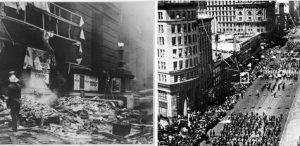
A radical pamphlet of mid-July read in part, “We are going to use a little direct action on the 22nd to show that militarism can’t be forced on us and our children without a violent protest.” It was in this environment that the Preparedness Parade found itself on July 22, 1916. In spite of that, the 3½ hour long procession of some 51,329 marchers, including 52 bands and 2,134 organizations, comprising military, civic, judicial, state and municipal divisions as well as newspaper, telephone, telegraph and streetcar unions, went ahead as planned. At 2:06pm, about a half hour after the parade began, a bomb concealed in a suitcase exploded on the west side of Steuart Street, just south of Market Street, near the Ferry Building. Ten bystanders were killed by the explosion, and 40 more were wounded, in what became the worst terrorist act in San Francisco history. The city and the nation were outraged, and they declared that justice would be served.
Two radical labor leaders, Thomas Mooney and Warren K Billings, were quickly arrested and tried for the  attack. In the trial that followed, the two men were convicted, despite widespread belief that they had been framed by the prosecution. Mooney was sentenced to death and Billings to life in prison. After evidence surfaced as to the corrupt nature of the prosecution, President Woodrow Wilson called on California Governor William Stephens to look further into the case. Two weeks before Mooney’s scheduled execution, Stephens commuted his sentence to life imprisonment, the same punishment Billings had received. Investigation into the case continued over the next two decades. By 1939, evidence of perjury and false testimony at the trial had so mounted that Governor Culbert Olson pardoned both men, and the true identity of the Preparedness Day bomber, or bombers, remains forever unknown.
attack. In the trial that followed, the two men were convicted, despite widespread belief that they had been framed by the prosecution. Mooney was sentenced to death and Billings to life in prison. After evidence surfaced as to the corrupt nature of the prosecution, President Woodrow Wilson called on California Governor William Stephens to look further into the case. Two weeks before Mooney’s scheduled execution, Stephens commuted his sentence to life imprisonment, the same punishment Billings had received. Investigation into the case continued over the next two decades. By 1939, evidence of perjury and false testimony at the trial had so mounted that Governor Culbert Olson pardoned both men, and the true identity of the Preparedness Day bomber, or bombers, remains forever unknown.
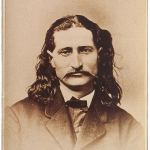 When we think of the Old West, cowboys, Indians, and outlaws come to mind…not to mention showdowns, or what might have been known as a duel, in years gone by. In reality, showdowns were not all that common…no matter what Hollywood tries to tell you. The men and women who went west were a tough bunch. In the beginning, it was mostly men who went west, and since there was no law in the West, altercations were bound to happen. Still, altercations that led to a showdown were not all that common. Rather than coolly confronting each other on a dusty street in a deadly game of quick draw, most men began shooting at each other in drunken brawls or spontaneous arguments. Ambushes and cowardly attacks were far more common than noble showdowns, but those who took the noble approach were far more respected.
When we think of the Old West, cowboys, Indians, and outlaws come to mind…not to mention showdowns, or what might have been known as a duel, in years gone by. In reality, showdowns were not all that common…no matter what Hollywood tries to tell you. The men and women who went west were a tough bunch. In the beginning, it was mostly men who went west, and since there was no law in the West, altercations were bound to happen. Still, altercations that led to a showdown were not all that common. Rather than coolly confronting each other on a dusty street in a deadly game of quick draw, most men began shooting at each other in drunken brawls or spontaneous arguments. Ambushes and cowardly attacks were far more common than noble showdowns, but those who took the noble approach were far more respected.
Southern emigrants brought to the West a crude form of the “code duello,” a highly formalized means of solving disputes between gentlemen with swords or guns that had its origins in European chivalry. Similar to the duels of times past, they thought it would bring some form of civility to the West. The duel influenced the informal western code of what constituted a legitimate and legal gun battle. Duels were not used to for very long. In fact, by the second half of the 19th century, few Americans still fought duels to solve their problems. 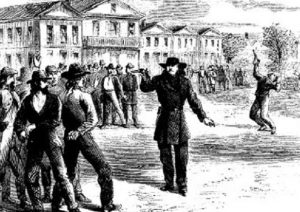 The western code required that a man resort to his six-gun only in defense of his honor or life, and only if his opponent was also armed. Also, a western jury was unlikely to convict a man in a shooting provided witnesses testified that his opponent had been the aggressor.
The western code required that a man resort to his six-gun only in defense of his honor or life, and only if his opponent was also armed. Also, a western jury was unlikely to convict a man in a shooting provided witnesses testified that his opponent had been the aggressor.
In what is thought to be the first western duel, Wild Bill Hickok, killed Davis Tutt on July 21, 1865. Hickok was a skilled gunman with a formidable reputation, who was eking out a living as a professional gambler in Springfield, Missouri. He quarreled with Tutt, a former Union soldier, but it is unclear what caused the dispute. Some people say it was over a card game while others say they fought over a woman. Whatever the cause, the two men agreed to a duel. The showdown took place the following day with crowd of onlookers watching as Hickok and Tutt confronted each other from opposite sides of the town square. When Tutt was about 75 yards away, Hickok shouted, “Don’t come any closer, Dave.” Tutt nervously drew his revolver and fired a shot that went wild. Hickok, by contrast, remained cool. He steadied his own revolver in his left hand and shot Tutt dead with a bullet through the chest. Hickok immediately turn and threatened Tutt’s friends…should they try to avenge his death.
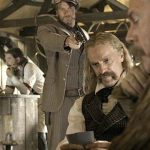
Having adhered to the code of the West, Hickok was acquitted of manslaughter charges. Nevertheless, those were rough times, and just eleven years later, Hickok died in a fashion far more typical of the violence of the day. A young gunslinger shot him in the back of the head while he played cards. Legend says that the hand Hickok was holding at the time of his death was two pair…black aces and black eights. The hand would forever be known as the “dead man’s hand.” Jack McCall shot Hickok from behind as he played poker at Nuttal & Mann’s Saloon in Deadwood, Dakota Territory on August 2, 1876. In one shooting is honor, and in another is a dishonor. McCall was executed for the murder on March 1, 1877.
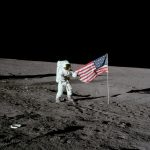 Most people know that at 10:56pm EDT, on July 20, 1969, American astronaut Neil Armstrong, 240,000 miles from Earth, speaks these words to more than a billion people listening at home, “That’s one small step for man, one giant leap for mankind.” Stepping off the lunar landing module Eagle, Armstrong became the first human to walk on the surface of the moon. The moment was historic, in more ways than one. Yes, the United States was the first nation to put a man on the moon. John F Kennedy’s dream had become a reality. On May 25, 1961, Kennedy made his famous appeal to a special joint session of Congress: “I believe this nation should commit itself to achieving the goal, before this decade is out, of landing a man on the moon and returning him safely to Earth.”
Most people know that at 10:56pm EDT, on July 20, 1969, American astronaut Neil Armstrong, 240,000 miles from Earth, speaks these words to more than a billion people listening at home, “That’s one small step for man, one giant leap for mankind.” Stepping off the lunar landing module Eagle, Armstrong became the first human to walk on the surface of the moon. The moment was historic, in more ways than one. Yes, the United States was the first nation to put a man on the moon. John F Kennedy’s dream had become a reality. On May 25, 1961, Kennedy made his famous appeal to a special joint session of Congress: “I believe this nation should commit itself to achieving the goal, before this decade is out, of landing a man on the moon and returning him safely to Earth.”
Most people know the rest of the story, or do they. At that moment, and for the next few moments, Neil Armstrong was the only human to step foot on the moon. He would always be the first human to step foot on the moon, but for a few minutes, he was the only human to do so. “Buzz” Aldrin joined him on the moon’s surface at 11:11pm, so now there were two humans who had walked on the moon, and while that was quite different from Armstrong’s feeling of being the only human to walk on the moon, it was still something so unique that I’m sure it had to be almost mind-boggling. Lots of us have done something that no one else in our  family or social circle has done, and the feeling of accomplishment is almost like a high, but this was something that no other human had ever done. Now that’s a high!! Of course, Armstrong wasn’t the only human to ever experience something like that. Many pioneers in different areas of history did the same thing. The first flight, the first car, the first heart transplant…the list goes on, but all of those had one thing in common. They were done on Earth. Armstrong was the first person to walk on a planet that was not the Earth. No matter how you look at it, this was unique, and Armstrong stood alone among human beings…not only for his accomplishment, but more for where it took place.
family or social circle has done, and the feeling of accomplishment is almost like a high, but this was something that no other human had ever done. Now that’s a high!! Of course, Armstrong wasn’t the only human to ever experience something like that. Many pioneers in different areas of history did the same thing. The first flight, the first car, the first heart transplant…the list goes on, but all of those had one thing in common. They were done on Earth. Armstrong was the first person to walk on a planet that was not the Earth. No matter how you look at it, this was unique, and Armstrong stood alone among human beings…not only for his accomplishment, but more for where it took place.
After “Buzz” Aldrin joined Neil Armstrong on the moon’s surface, they took photographs of the terrain, planted a United States flag on its surface. Then they ran a few simple scientific tests, and spoke with President Richard M Nixon via Houston. By 1:11am on July 21, both astronauts were back in the lunar module and the hatch was closed. The two men slept that night on the surface of the moon. Then, at 1:54pm the Eagle began its ascent back to the command module. Among the items left on the surface of the moon was a plaque that read: “Here men from the planet Earth first set foot on the moon–July 1969 A.D–We came in peace for all mankind.” There would be five more successful lunar landing missions, and one unplanned lunar swing-by, when Apollo 13 experienced a malfunction that nearly made it impossible to return to Earth. The last men to walk on the moon, astronauts Eugene Cernan and Harrison Schmitt of the Apollo 17 mission, left the lunar surface on December 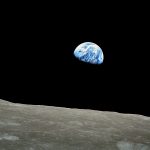 14, 1972. In all, 12 men walked on the moon. All Americans, they were, on Apollo 11: Neil Armstrong (NASA Civilian) and Buzz Aldrin (USAF), on Apollo 12: Pete Conrad (US Navy) and Alan Bean (US Navy), on Apollo 14: Alan Shepard (US Navy) and Edgar Mitchell (US Navy), on Apollo 15: David Scott (USAF) and James Irwin (USAF), on Apollo 16: John Young (US Navy) and Charles Duke (USAF), and on Apollo 17: Gene Cernan (US Navy) and Harrison Schmitt (NASA Civilian). While Neil Armstrong was the only human to walk on the moon’s surface for 15 minutes in time, there were 11 others who had the distinct honor of walking on the moon, and while they weren’t the only humans, they were the only 12 humans to do so, and that had to feel really strange to them for the rest of their lives.
14, 1972. In all, 12 men walked on the moon. All Americans, they were, on Apollo 11: Neil Armstrong (NASA Civilian) and Buzz Aldrin (USAF), on Apollo 12: Pete Conrad (US Navy) and Alan Bean (US Navy), on Apollo 14: Alan Shepard (US Navy) and Edgar Mitchell (US Navy), on Apollo 15: David Scott (USAF) and James Irwin (USAF), on Apollo 16: John Young (US Navy) and Charles Duke (USAF), and on Apollo 17: Gene Cernan (US Navy) and Harrison Schmitt (NASA Civilian). While Neil Armstrong was the only human to walk on the moon’s surface for 15 minutes in time, there were 11 others who had the distinct honor of walking on the moon, and while they weren’t the only humans, they were the only 12 humans to do so, and that had to feel really strange to them for the rest of their lives.
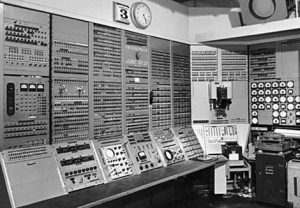 These days, being connected to the internet is commonplace. We connect from our computer, laptop, tablet, and even our phone. Many occupations, including the one I am in could not really function without the internet. When the computers go down, we are shut down too. For most of us, the internet is so much a part of our lives, that we simply cannot imagine life without it. Nevertheless, the reality is that until quite recently, there was no internet. I know people who think that might have been a better time, but I disagree. In fact, I think the people who say they think that, really have no idea just how bad that would be, and if they tried it once, they would change their minds quickly. People don’t realize how many things depend on the internet.
These days, being connected to the internet is commonplace. We connect from our computer, laptop, tablet, and even our phone. Many occupations, including the one I am in could not really function without the internet. When the computers go down, we are shut down too. For most of us, the internet is so much a part of our lives, that we simply cannot imagine life without it. Nevertheless, the reality is that until quite recently, there was no internet. I know people who think that might have been a better time, but I disagree. In fact, I think the people who say they think that, really have no idea just how bad that would be, and if they tried it once, they would change their minds quickly. People don’t realize how many things depend on the internet.
The first real idea of information available at our fingertips began to form on October 4, 1957, when the Soviet Union launched the world’s first manmade satellite into orbit. Known as Sputnik, the satellite did not do much. It tumbled aimlessly around in outer space, sending blips and bleeps from its radio transmitters as it circled the Earth. Nevertheless, to many Americans, the one foot diameter Sputnik was proof of something alarming. Up to this point, scientists and engineers in the United States had been designing bigger cars and better television sets, but the Soviets had been focusing on…less frivolous things, and they were going to win the Cold War because of it. Americans saw that information could eventually be transmitted back to the Soviets concerning American military and government secrets. It was the dawning of the age of spy satellites.
Sputnik’s launch, brought about the era of science and technology in America. In an effort to keep up, schools began teaching subjects like chemistry, physics and calculus. The government gave grants to corporations, who invested them in scientific research and development. The federal government formed new agencies, such as the National Aeronautics and Space Administration (NASA) and the Department of Defense’s Advanced Research Projects Agency (ARPA), to develop space-age technologies such as rockets, weapons and computers. Of course, the computer didn’t do nearly as much as it does these days, and it was the size of a small house. In 1962, a scientist from M.I.T. and ARPA named J.C.R. Licklider proposed a solution to this problem. His proposal  was a “galactic network” of computers that could talk to one another. Such a network would enable government leaders to communicate even if the Soviets destroyed the telephone system. Then came “packet switching.” Packet switching breaks data down into blocks, or packets, before sending it to its destination. That way, each packet can take its own route from place to place. Without packet switching, the government’s computer network, which is now known as the ARPAnet, would have been just as vulnerable to enemy attacks as the phone system. At least now computers did more, but they were still big.
was a “galactic network” of computers that could talk to one another. Such a network would enable government leaders to communicate even if the Soviets destroyed the telephone system. Then came “packet switching.” Packet switching breaks data down into blocks, or packets, before sending it to its destination. That way, each packet can take its own route from place to place. Without packet switching, the government’s computer network, which is now known as the ARPAnet, would have been just as vulnerable to enemy attacks as the phone system. At least now computers did more, but they were still big.
In 1969, ARPAnet delivered its first message. A “node-to-node” communication from one computer located in a research lab at UCLA, to the second located at Stanford. The message “LOGIN” was short and simple, and it crashed the ARPA network. Wow!! Things really are different today. The Stanford computer only received the note’s first two letters. By the end of 1969, just four computers were connected to the Arpanet. During the 1970s the network grew steadily. In 1971, it added the University of Hawaii’s ALOHAnet, and two years later it added networks at London’s University College and the Royal Radar Establishment in Norway. As packet-switched computer networks multiplied, it became more difficult for them to integrate into a single worldwide “Internet.” By the end of the 1970s, a computer scientist named Vinton Cerf had begun to solve this problem by developing a way for all of the computers on all of the world’s mini-networks to communicate with one another. He called his invention “Transmission Control Protocol,” or TCP. Later, he added an additional protocol, known as “Internet Protocol.” The acronym we use to refer to these today is TCP/IP. One writer describes Cerf’s protocol as “the ‘handshake’ that introduces distant and different computers to each other in a virtual space.”
Cerf’s protocol transformed the Internet into a worldwide network. Throughout the 1980s, researchers and scientists used it to send files and data from one computer to another. In 1991 the Internet changed again. That year, a computer programmer in Switzerland named Tim Berners-Lee introduced the World Wide Web…an Internet that was not simply a way to send files from one place to another, but was itself a “web” of information that anyone on the Internet could retrieve. Berners-Lee created the Internet that we know and use today. Since then, the Internet has changed in many ways, and will likely continue to change as time goes on.  In 1992, a group of students and researchers at the University of Illinois developed a browser that they called Mosaic, later known as Netscape. Mosaic offered a user-friendly way to search the Web. It allowed users to see words and pictures on the same page for the first time and to navigate using scrollbars and clickable links. Then Congress decided that the Web could be used for commercial purposes. Companies developed websites of their own, and e-commerce entrepreneurs began to use the Internet to sell goods directly to customers. These days, social networking sites like Facebook have become a popular way for people of all ages, including me, to stay connected. Today, almost one-third of the world’s 6.8 billion people use the Internet regularly.
In 1992, a group of students and researchers at the University of Illinois developed a browser that they called Mosaic, later known as Netscape. Mosaic offered a user-friendly way to search the Web. It allowed users to see words and pictures on the same page for the first time and to navigate using scrollbars and clickable links. Then Congress decided that the Web could be used for commercial purposes. Companies developed websites of their own, and e-commerce entrepreneurs began to use the Internet to sell goods directly to customers. These days, social networking sites like Facebook have become a popular way for people of all ages, including me, to stay connected. Today, almost one-third of the world’s 6.8 billion people use the Internet regularly.
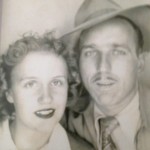 Everyone’s home life growing up is different. Some homes are very reserved, some are chaotic, and others, like mine are simply wonderful. We always knew that our parents loved us and that they loved each other too. In our house, there were kisses and hugs all around, but we got the biggest kick out of our parents kissing. Dad would come home from work, and give Mom a big kiss, and my sisters and I started singing a song we made up…”Mommy and Daddy are kissing!!” The more we sang the song, the more they continued to kiss. We loved teasing them about kissing, and they love having us tease them. Of course, there was no embarrassment on either side, because we loved that our parents demonstrated their love for each other. What makes a kid feel more secure in the stability of their parents marriage, than a daily show of love.
Everyone’s home life growing up is different. Some homes are very reserved, some are chaotic, and others, like mine are simply wonderful. We always knew that our parents loved us and that they loved each other too. In our house, there were kisses and hugs all around, but we got the biggest kick out of our parents kissing. Dad would come home from work, and give Mom a big kiss, and my sisters and I started singing a song we made up…”Mommy and Daddy are kissing!!” The more we sang the song, the more they continued to kiss. We loved teasing them about kissing, and they love having us tease them. Of course, there was no embarrassment on either side, because we loved that our parents demonstrated their love for each other. What makes a kid feel more secure in the stability of their parents marriage, than a daily show of love.
Of course, kissing wasn’t the only way my parents showed their love for each other. My dad was always the 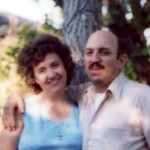 gentleman. He was very protective of my mom. He treated her like a queen, and made sure that we respected her too. He was a hard working man, and we never wanted for anything that we needed. Nevertheless, it was never the things that made us rich. It was the love of our parents that made us rich. There is nothing more comforting than to know that your parents will be there with you and for you. And mom, for her part, always made our home welcoming and inviting, not to mention teaching us to keep house and to cook. One of my favorite memories of my childhood was coming home for lunch on a school day, to find chicken noodle soup and grilled cheese sandwiches. That was my very favorite lunch, and it was great to come home to Mom’s cooking.
gentleman. He was very protective of my mom. He treated her like a queen, and made sure that we respected her too. He was a hard working man, and we never wanted for anything that we needed. Nevertheless, it was never the things that made us rich. It was the love of our parents that made us rich. There is nothing more comforting than to know that your parents will be there with you and for you. And mom, for her part, always made our home welcoming and inviting, not to mention teaching us to keep house and to cook. One of my favorite memories of my childhood was coming home for lunch on a school day, to find chicken noodle soup and grilled cheese sandwiches. That was my very favorite lunch, and it was great to come home to Mom’s cooking.
I’s like to say that there was never any drama in our house, but my parents had five daughters, and…well, drama is just a part of the deal. You get five girls to the age of their teens or close to it, with one phone, and everyone wanting to have their turn, and you have drama…not to mention the fights over 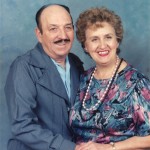 the bathroom with all of us trying to get ready for school or a date. I suppose mom understood, but dad had to be a saint, and that’s all there is to it. With one bathroom, a wife, and five daughters, dad just had to wait…forever!!
the bathroom with all of us trying to get ready for school or a date. I suppose mom understood, but dad had to be a saint, and that’s all there is to it. With one bathroom, a wife, and five daughters, dad just had to wait…forever!!
Nevertheless, while there may have been a little bit of drama, our home was a house filled with love, laughter, singing, and yes with mommy and daddy kissing. Today would have been my parents’ 64th wedding anniversary. They will be spending it together in Heaven. I’m sure it will be a beautiful day, and I wish we could spend it with them, but for now, that is not to be. Happy anniversary Mom and Dad. We love and miss you very much.
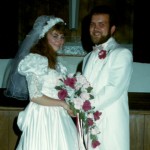 Every wedding anniversary is special, but the anniversaries wouldn’t even exist, were it not for the day to day living of the couple. Marriage is a lot of work, and when a couple marries young, it’s hard to say if they will have the wherewithal to make a go of it. My oldest daughter, Corrie Petersen was just two weeks past the age of 18 when she and her husband Kevin got married. Many people wouldn’t have give them ten cents for their chances of staying together, but they have proven people wrong time and time again. Now, a full 24 years into their marriage, they are like one unit. Of course, that is what God meant when he said in Mark 10:8, “And they two shall be one flesh: so then they are no more two, but one flesh.” That is how it is for Corrie and Kevin. They work so well as a team. Corrie and Kevin have gone through so many changes in their lives, and they have weathered each storm, to come out on the other side, stronger than ever. Oh, I don’t mean to say that there haven’t been some tough times, because every marriage has those times. It’s not the number of tough times a marriage goes through, but rather how a marriage comes through the tough times.
Every wedding anniversary is special, but the anniversaries wouldn’t even exist, were it not for the day to day living of the couple. Marriage is a lot of work, and when a couple marries young, it’s hard to say if they will have the wherewithal to make a go of it. My oldest daughter, Corrie Petersen was just two weeks past the age of 18 when she and her husband Kevin got married. Many people wouldn’t have give them ten cents for their chances of staying together, but they have proven people wrong time and time again. Now, a full 24 years into their marriage, they are like one unit. Of course, that is what God meant when he said in Mark 10:8, “And they two shall be one flesh: so then they are no more two, but one flesh.” That is how it is for Corrie and Kevin. They work so well as a team. Corrie and Kevin have gone through so many changes in their lives, and they have weathered each storm, to come out on the other side, stronger than ever. Oh, I don’t mean to say that there haven’t been some tough times, because every marriage has those times. It’s not the number of tough times a marriage goes through, but rather how a marriage comes through the tough times.
Part of what makes a great marriage, is when two people are going in the same direction, with the same goals. It’s not that they can never have differing ideas about things, but rather that they are able to see the other side of the coin, or the other person’s viewpoint. Corrie and Kevin do that quite well. They also support each other in every new venture they might take. I think most marriages find themselves with ever changing hobbies and such, and some can be time consuming. If the spouse is not supportive of the new hobby, there can be a few hard feelings. Over the years Corrie and Kevin have had a few side businesses, such as making cross necklaces, or stained glass, and Corrie was also a virtual assistant. Those things take time, and if you  don’t have the support of your spouse, people can encounter problems. Sometimes, even if they are supportive, there can be time conflicts. There wasn’t for Corrie and Kevin, because they often worked together on these things. I’m sure that is not such a strange thing, but not every family has a good working relationship like that.
don’t have the support of your spouse, people can encounter problems. Sometimes, even if they are supportive, there can be time conflicts. There wasn’t for Corrie and Kevin, because they often worked together on these things. I’m sure that is not such a strange thing, but not every family has a good working relationship like that.
Corrie and Kevin are two very compatible people and while their marriage started out early in their lives, they are, and always have been very much in love. Theirs is a match made in Heaven and one that will last until death parts them…and I am very happy that they have each other. Today is Corrie and Kevin’s 24th wedding anniversary. Happy anniversary Corrie and Kevin!! We love you both very much!!
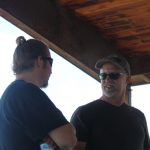
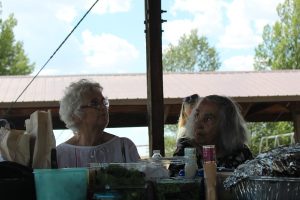 Every family has its traditions, but I don’t know of many families that have a twice a year gathering of aunts, uncles, and multiple levels of cousins. In fact, I don’t know if I know of any families that do that…but my mom’s family does. The Byer family has been having these gatherings ever since we got too big to all gather at Grandma and Grandpa Byer’s house for the holidays. Grandma and Grandpa have been in Heaven now for 37 years and 29 years respectively, but their tradition still holds. It was their desire that their kids stay close, and in making that one request, they have successfully kept all of their grandchildren and great grandchildren close too.
Every family has its traditions, but I don’t know of many families that have a twice a year gathering of aunts, uncles, and multiple levels of cousins. In fact, I don’t know if I know of any families that do that…but my mom’s family does. The Byer family has been having these gatherings ever since we got too big to all gather at Grandma and Grandpa Byer’s house for the holidays. Grandma and Grandpa have been in Heaven now for 37 years and 29 years respectively, but their tradition still holds. It was their desire that their kids stay close, and in making that one request, they have successfully kept all of their grandchildren and great grandchildren close too.
Some years, we have quite a crowd, and other years, not so much, but those who come out always have a nice time. Maybe it was the heat, or maybe this was an off year, but we did have a smaller crowd. Nevertheless, it was good to visit with aunts Virginia Beadle, Bonnie McDaniels, Dixie Richards, and Sandy Pattan, as well as Uncle Wayne Byer. All are doing well, and that makes me glad, because I’m not ready to lose any more of the aunts or uncles. most of the usual group was there for the picnic. We have those who like the heat and those who can’t take it, so the picnic tends to have a smaller turnout. Most of the families were represented, with just a few exceptions, but it happens.
Even though it was hot, we had a great time. A breeze kicked up and it took the edge off of the heat of the day. Everyone got a chance to catch up on the lives of the other family members. Our busy lives sometimes make it hard to stay in touch on a day to day basis, even though Facebook has helped with that some. I love having a chance to see all of the younger members of our family too. They are all so full of life. Talking with them is so interesting, and I know that for the aunts and uncles, it makes them feel a part of the younger set’s life. At least that is how it makes me feel.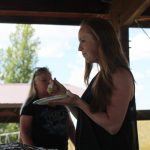
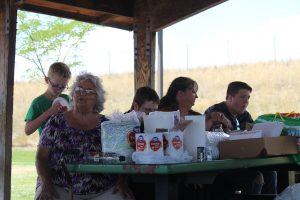
I suppose lots of people would think the Byer family traditions are a bit unusual, but I like them. I like being close to the family, both on Facebook and in person. Each and every family member has something amazing to share. Each one is special in their own way, and together, we make a very special family. I am very blessed to be a part of such an amazing family. I love you all very much, and it was great to see you today.
 When my husband’s aunt, Helen Knox passed away on January 11, 2017 at the good old age of 99 years, her passing left her soul mate, Uncle Frank Knox to carry on alone…at least in that the love of his life was not longer with him. Of course, his sons are still here, and his grandchildren, one of whom I have had the great privilege of getting to know over Facebook since her grandmother’s passing. Yesterday morning, it was Frank’s granddaughter, Kate West who passed along the sad news that Uncle Frank had gone to Heaven to join his sweet wife, Helen. My thoughts immediately went back to the times that Frank and Helen came for visits, and what wonderful and interesting people they were. I wanted to write a tribute to Frank about the times I remembered, but then I read about Kate’s memories, and…well, I hope she won’t mind if I take a chapter from her Lifebook for this story. Her memories are so sweet and so thoughtful, that it became very clear to me and to anyone who read her words, that her grandfather was very, very special to her. Nothing I could have said could even begin to compare to the words of his Kate…or to those of her dad, Greg Knox, who told me that the date of Frank’s passing was the same date he and Helen married, just 71 years later. That is a very special day to Frank and Helen.
When my husband’s aunt, Helen Knox passed away on January 11, 2017 at the good old age of 99 years, her passing left her soul mate, Uncle Frank Knox to carry on alone…at least in that the love of his life was not longer with him. Of course, his sons are still here, and his grandchildren, one of whom I have had the great privilege of getting to know over Facebook since her grandmother’s passing. Yesterday morning, it was Frank’s granddaughter, Kate West who passed along the sad news that Uncle Frank had gone to Heaven to join his sweet wife, Helen. My thoughts immediately went back to the times that Frank and Helen came for visits, and what wonderful and interesting people they were. I wanted to write a tribute to Frank about the times I remembered, but then I read about Kate’s memories, and…well, I hope she won’t mind if I take a chapter from her Lifebook for this story. Her memories are so sweet and so thoughtful, that it became very clear to me and to anyone who read her words, that her grandfather was very, very special to her. Nothing I could have said could even begin to compare to the words of his Kate…or to those of her dad, Greg Knox, who told me that the date of Frank’s passing was the same date he and Helen married, just 71 years later. That is a very special day to Frank and Helen.
While Kate is very sad that her grandfather is gone, she is glad that he is with her grandmother again. They 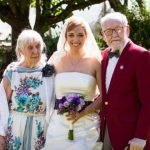 had lived long and happy lives, with 71 of those years lived as husband and wife. When her grandmother passed away, Kate found herself distressed because her grandfather was now without his other half. For Kate, the connection she and her grandpa had was the closest relationship she had with any of her grandparents. Part of the reason is that Frank and Helen lived with Kate’s family for 4 years, from the time Kate was 8 until she was 12. Helen was a little more quiet than her husband was. Frank was always very outgoing, and that made him easy to get to know. The relationship Kate had with her grandfather reminds me of the relationship I had with my Uncle Bill Spencer. Kate’s grandpa, or maybe her dad, taught her the game of cribbage, like my uncle did with me. After that playing cribbage became a ritual. The family used to go camping, and it always seemed to rain, at least one day of the trip. That was all it took for Kate and Frank to get out the cribbage board and pass the time in the friendly rivalry that cribbage always is. Those are the memories that will last Kate for the rest of her life…the memories that will keep her grandfather in her thoughts. She won’t pass a cribbage board without thinking of their games, or hear the rain without thinking of her grandfather. He will always live in her heart, as he will in the hearts of all of those who loved him.
had lived long and happy lives, with 71 of those years lived as husband and wife. When her grandmother passed away, Kate found herself distressed because her grandfather was now without his other half. For Kate, the connection she and her grandpa had was the closest relationship she had with any of her grandparents. Part of the reason is that Frank and Helen lived with Kate’s family for 4 years, from the time Kate was 8 until she was 12. Helen was a little more quiet than her husband was. Frank was always very outgoing, and that made him easy to get to know. The relationship Kate had with her grandfather reminds me of the relationship I had with my Uncle Bill Spencer. Kate’s grandpa, or maybe her dad, taught her the game of cribbage, like my uncle did with me. After that playing cribbage became a ritual. The family used to go camping, and it always seemed to rain, at least one day of the trip. That was all it took for Kate and Frank to get out the cribbage board and pass the time in the friendly rivalry that cribbage always is. Those are the memories that will last Kate for the rest of her life…the memories that will keep her grandfather in her thoughts. She won’t pass a cribbage board without thinking of their games, or hear the rain without thinking of her grandfather. He will always live in her heart, as he will in the hearts of all of those who loved him.
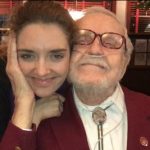
Having moved to Spokane, Kate didn’t get to see her grandfather as often during those last years, and while she feels the regrets that come from a busy life and the difficulty distance brings to staying in touch, I can tell her that for her grandfather, the memories of the fun times with his cribbage partner kept a smile on his face, and she lit up his day with the love that showed on her face for her grandfather. While we may not realize what a huge impact we have of the life of another, they know it. Those around us who care about us, are the bright lights in our lives. That’s what Kate was to her grandfather. Uncle Frank will be greatly missed by all of us, who loved him. We look forward to seeing you again in Heaven, Uncle Frank.

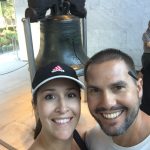 My nephew, Shannon Moore, who is married to my niece Lindsay, is the Special Teams Coordinator and Tight Ends coach at East Carolina University…Home of the Pirates. Shannon is totally in his element as a coach, having come from the Wyoming Cavalry team, where he and Lindsay met; to Brookings, South Dakota; to Miami, Florida; to Greenville, North Carolina, where he is today. Every move he has made has been a move up in status. For Shannon, Greenville is a personal favorite place. The town is a real football town, and game day is lots of fun. As the coach, it’s like a big celebration, and he gets to be right there in the middle of it all. Shannon thrives on all things football, and I’m quite sure all of the other sports as well.
My nephew, Shannon Moore, who is married to my niece Lindsay, is the Special Teams Coordinator and Tight Ends coach at East Carolina University…Home of the Pirates. Shannon is totally in his element as a coach, having come from the Wyoming Cavalry team, where he and Lindsay met; to Brookings, South Dakota; to Miami, Florida; to Greenville, North Carolina, where he is today. Every move he has made has been a move up in status. For Shannon, Greenville is a personal favorite place. The town is a real football town, and game day is lots of fun. As the coach, it’s like a big celebration, and he gets to be right there in the middle of it all. Shannon thrives on all things football, and I’m quite sure all of the other sports as well.
The cool thing for Shannon and Lindsay is the fact that he has the summers off. They have been spending the summer taking trips here and there. This year, they did a tour of the Northeast. The trip started out in Niagara Falls for Independence Day. Now, I think that would be a very cool place to be for the holiday. Shannon and Lindsay rode on the Maid of the Mist ferry boat to the base of the falls, which is an amazing ride. From Niagara Falls, their trip took them to Portland, Maine. Then they went to New Hampshire and Massachusetts, where 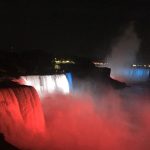
 they went to the Baseball Hall of Fame. The next leg of their trip took them to Vermont for a nice dinner. And what tour of the Northeast would be complete without a trip to New York City. They went to the Statue of Liberty, Ellis island, and the Brooklyn bridge, as well as taking in a Yankees game. They had been there before, but it was right after Hurricane Sandy, so they were unable to go to those places. They also toured the sites for Seinfeld and You’ve Got Mail. Lindsay tells me that it was “waaaay fun!!” The next leg of their trip was a ride on the Amtrak to Philadelphia to see a Phillies Game, the Liberty Bell and the Rocky Statue. Finally they took the Amtrak back to North Carolina. Their grand tour of the Northeast took them on a plane, train, automobile, and ferry. Lindsay and Shannon have set a goal to see all 50 states. In the Northeast, they have seven states left. They only check off the states, when both of them have been to the state.
they went to the Baseball Hall of Fame. The next leg of their trip took them to Vermont for a nice dinner. And what tour of the Northeast would be complete without a trip to New York City. They went to the Statue of Liberty, Ellis island, and the Brooklyn bridge, as well as taking in a Yankees game. They had been there before, but it was right after Hurricane Sandy, so they were unable to go to those places. They also toured the sites for Seinfeld and You’ve Got Mail. Lindsay tells me that it was “waaaay fun!!” The next leg of their trip was a ride on the Amtrak to Philadelphia to see a Phillies Game, the Liberty Bell and the Rocky Statue. Finally they took the Amtrak back to North Carolina. Their grand tour of the Northeast took them on a plane, train, automobile, and ferry. Lindsay and Shannon have set a goal to see all 50 states. In the Northeast, they have seven states left. They only check off the states, when both of them have been to the state.
As if the summer hasn’t been busy enough, Shannon has also been keeping himself busy with golfing and yard work. They will try to get to the beach a few times before fall, and they did make a trip back home to Wyoming 
 for a visit, stopping to see Shannon’s folks too along the way. I think it’s been a long time since they have driven back to Wyoming. Lindsay was kind of amazed that it took three days to drive home. In the fall, it will be back too football training again. Lindsay is so cute. Every time I ask her for information, she always adds one little thing, this time she said, “Oh yeah AND I know I am biased but man…he is the best husband ever and the nicest person ever!! Such a kind and generous person!!” I love to see that!! Today is Shannon’s birthday. Happy birthday Shannon!! Have a great day!! We love you!!
for a visit, stopping to see Shannon’s folks too along the way. I think it’s been a long time since they have driven back to Wyoming. Lindsay was kind of amazed that it took three days to drive home. In the fall, it will be back too football training again. Lindsay is so cute. Every time I ask her for information, she always adds one little thing, this time she said, “Oh yeah AND I know I am biased but man…he is the best husband ever and the nicest person ever!! Such a kind and generous person!!” I love to see that!! Today is Shannon’s birthday. Happy birthday Shannon!! Have a great day!! We love you!!

